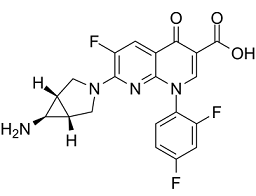Trovafloxacin (CP-99219)
This product is for research use only, not for human use. We do not sell to patients.

For small sizes, please check our retail website as below: www.invivochem.com
| Size | Price | Stock |
|---|---|---|
| 100mg | $650 | Check With Us |
| 200mg | $975 | Check With Us |
| 500mg | $1645 | Check With Us |
Cat #: V39585 CAS #: 147059-72-1 Purity ≥ 99%
Description: Trovafloxacin (CP-99219) is a broad-spectrum quinolone antibiotic that inhibits DNA supercoiling in various bacteria by blocking the activity of DNA gyrase and topoisomerase IV.
Top Publications Citing Invivochem Products
Publications Citing InvivoChem Products
Product Promise

- Physicochemical and Storage Information
- Protocol
- Related Biological Data
- Stock Solution Preparation
- Quality Control Documentation
| Molecular Weight (MW) | 416.35 |
|---|---|
| Molecular Formula | C20H15F3N4O3 |
| CAS No. | 147059-72-1 |
| SMILES Code | O=C(C1=CN(C2=CC=C(F)C=C2F)C3=NC(N4C[C@@]5([H])C(N)[C@@]5([H])C4)=C(F)C=C3C1=O)O.CS(=O)(O)=O |
| Synonyms | CP 99219; CP-99,219; CP-99219; CP 99219; CP99219; CP 99,219; Trovafloxacin mesylate; Band name: Trovan;Turvel. |
| Protocol | In Vitro | Trovafloxacin prolongs TNF-induced activation of MAPKs and IKKα/β activation in HepG2. Trovafloxacin (20 µM; 24 hours; HepG2 cells) and TNF (4 ng/mL) incubation increases expression of early NF-κB-related factors A20 and IκBα. Trovafloxacin (20 µM; 24 hours; HepG2 cells) and tumor necrosis factor (TNF; 4 ng/mL) incubation induces apoptosis and increases leakage of lactate dehydrogenase (LDH) in HepG2 cells. |
|---|---|---|
| In Vivo | Trovafloxacin, when administered in combination with lipopolysaccharide (LPS) or TNF to mice induces severe liver toxicity associated with vast apoptotic areas in the liver, increased serum levels of alanine amino transferases (ALT) and pro-inflammatory cytokines. Trovafloxacin (150 mg/kg; oral administration; male C57BL/6 J mice) treatment disrupts TNF-induced p65 nuclear translocation. Trovafloxacin treatment increases expression of early NF-κB-related factors A20 and IκBα. |
These protocols are for reference only. InvivoChem does not
independently validate these methods.
| Solvent volume to be added | Mass (the weight of a compound) | |||
|---|---|---|---|---|
| Mother liquor concentration | 1mg | 5mg | 10mg | 20mg |
| 1mM | 2.4018 mL | 12.0091 mL | 24.0183 mL | 48.0365 mL |
| 5mM | 0.4804 mL | 2.4018 mL | 4.8037 mL | 9.6073 mL |
| 10mM | 0.2402 mL | 1.2009 mL | 2.4018 mL | 4.8037 mL |
| 20mM | 0.1201 mL | 0.6005 mL | 1.2009 mL | 2.4018 mL |
The molarity calculator equation
Mass(g) = Concentration(mol/L) × Volume(L) × Molecular Weight(g/mol)
Mass
=
Concentration
×
Volume
×
Molecular Weight*
The dilution calculator equation
Concentration(start)
×
Volume(start)
=
Concentration(final)
×
Volume(final)
This equation is commonly abbreviated as: C1 V1 = C2 V2
Concentration(start)
C1
×
Volume(start)
V1
=
Concentration(final)
C2
×
Volume(final)
V2
Step One: Enter information below
Dosage mg/kg
Average weight of animals g
Dosing volume per animal µL
Number of animals
Step Two: Enter the in vivo formulation
%DMSO
+
%
+
%Tween 80
+
%ddH2O
Calculation Results:
Working concentration:
mg/ml;
Method for preparing DMSO master liquid:
mg
drug pre-dissolved in
µL
DMSO(Master liquid concentration
mg/mL)
,Please contact us first if the concentration exceeds the DMSO solubility of the batch of drug.
Method for preparing in vivo formulation:
Take
µL
DMSO master liquid, next add
µL
PEG300, mix and clarify, next add
µL
Tween 80,mix and clarify, next add
µL
ddH2O,mix and clarify.
Note:
- (1) Please be sure that the solution is clear before the addition of next solvent. Dissolution methods like vortex, ultrasound or warming and heat may be used to aid dissolving.
- (2) Be sure to add the solvent(s) in order.




































